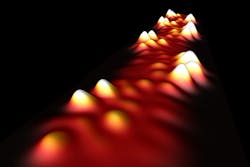A team of scientists at the University of California, Berkeley have created a metallic wire made entirely of carbon, setting the stage for research into carbon-based transistors and computers. Carbon-based transistors could boost computer speed by more than a thousandfold and reduce power consumption.
The team has been working for several years on making semiconductors and insulators from graphene nanoribbons—narrow, one-dimensional strips or ribbons of atom-thick graphene composed of carbon atoms in an interconnected hexagonal pattern. The metallic nanoribbons are assembled from smaller building blocks, with each block contributing an electron to flow along the nanoribbon. These are created chemically then arranged and and imaged on flat surfaces using a scanning tunneling microscope.
Heat was applied to induce the building locks molecules to chemically react and join together. The resulting graphene nanoribbon could be used to move conducting electrons between semiconducting nanoribbons in an all-carbon transistor.
There are other carbon-based materials that can be metallic, such as 2D sheets of graphene and carbon nanotubes. But shaping 2D sheets of graphene into nanometer scale strips spontaneously turns them into semiconductors or insulators. And carbon nanotubes, which are good conductors, cannot be transformed into wires with the same precision and reproducibility as carbon nanoribbons.
Graphene, which is pure carbon, is a leading contender for these next-generation, carbon-based computers. Narrow strips of graphene are primarily semiconductors. The challenge is to make them act as conductors and insulators so that transistors and processors could all be made of carbon. Carbon-based computers should switch many times faster than silicon versions and use only a fraction of the power.

